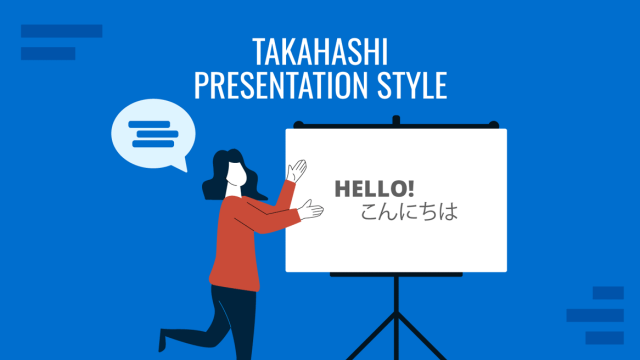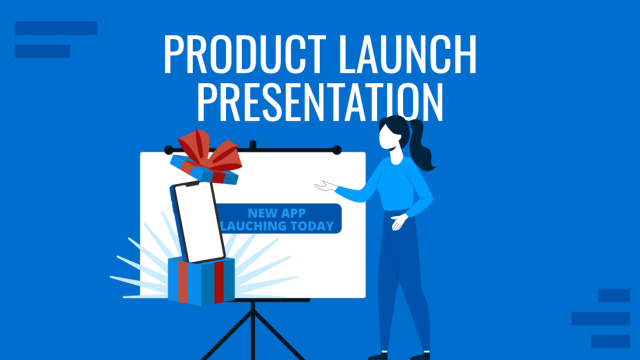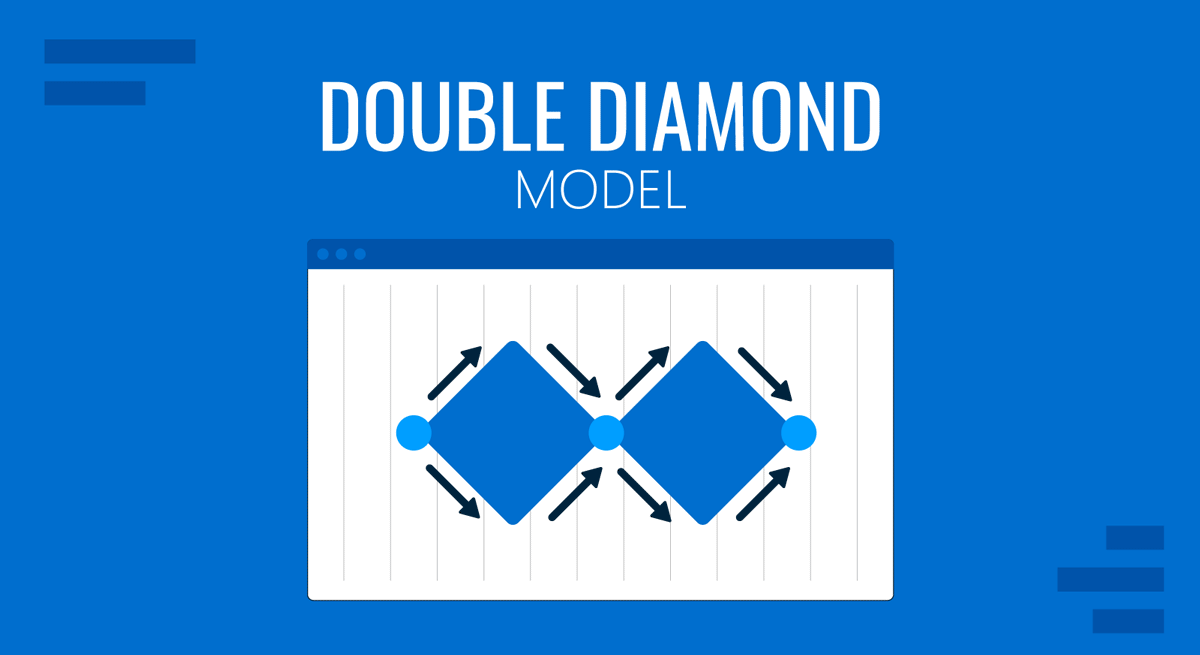
The Double Diamond Model, initially developed by the UK Design Council in 2005, is a structured approach to problem solving that separates the thinking process into four stages: Discover, Define, Develop, and Deliver. While it is primarily associated with design and innovation, the model has strong applications in strategic presentations, particularly when you need to guide an audience through a complex concept, align stakeholders on a course of action, or present the outcome of a project.
This article will introduce the model, explain its relevance to presentation design, show how it complements other strategic frameworks, and then take you through the process of creating a presentation using the Double Diamond structure from start to finish.
Table of Contents
- What is the Double Diamond Model?
- Strategy Diamond vs. Double Diamond Model
- How the Double Diamond Complements Other Presentation Frameworks
- How to Use the Double Diamond in Presentation Design
- FAQs
- Final Words
What is the Double Diamond Model?
The Double Diamond gets its name because its visual form consists of two connected diamond shapes. Each diamond represents a phase of the creative and decision-making process. The left diamond focuses on defining the problem, while the right diamond focuses on developing the solution. Each diamond moves through a divergent stage, where options and insights expand, and a convergent stage, where focus is narrowed.
The four stages are:
- Discover: Conduct research and exploration to gather insights, data, and perspectives on the problem.
- Define: Filtering, synthesizing, and clearly articulating the problem or opportunity.
- Develop: Generating and iterating possible solutions, often through prototyping or modeling.
- Deliver: Select, refine, and present the final solution for implementation.
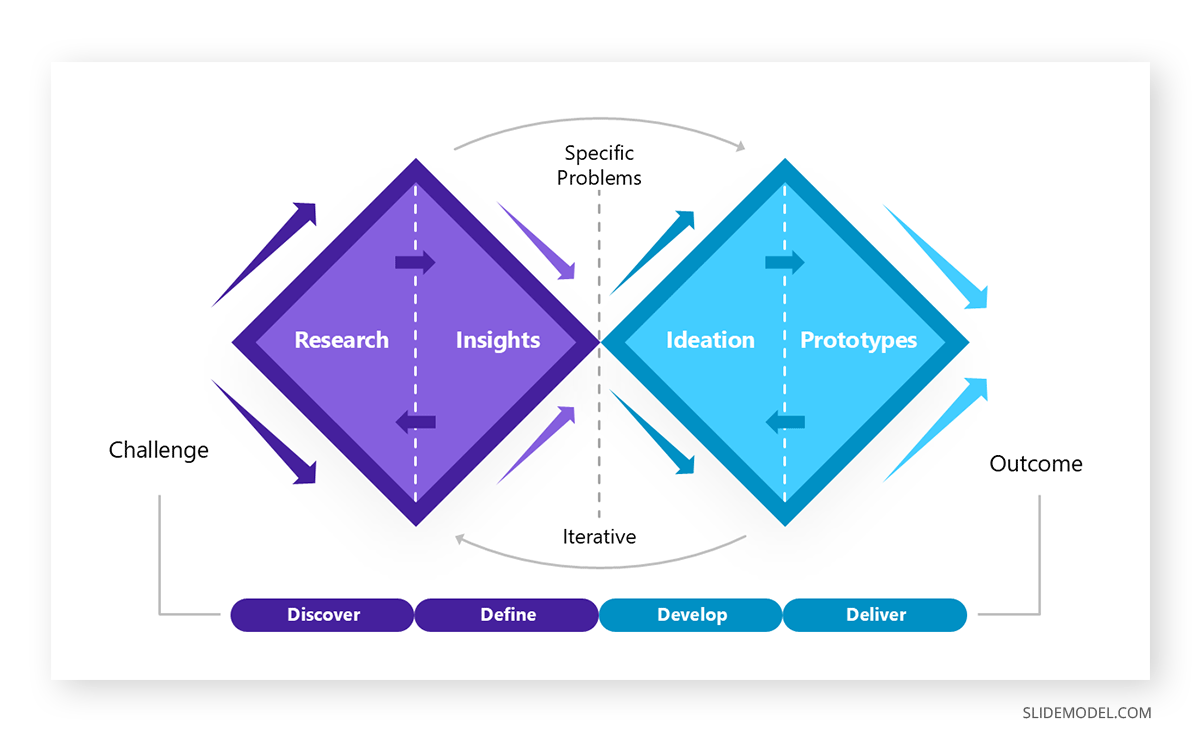
The Double Diamond is widely used beyond its original design because its structure mirrors the way complex decisions are made in a methodical yet creative manner. It provides a clear path for guiding an audience from the earliest stages of understanding an issue to the final point of action. In a presentation setting, this approach is efficient when you need to gain support for a proposal, justify a decision that has already been made, communicate the progress and results of a project, or ensure that multiple teams share a common vision moving forward.
Recommended lecture: Progress Report Presentation
Rather than presenting conclusions in isolation, the Double Diamond allows you to take your audience inside the process that led to those conclusions. This means showing how you explored possibilities, examined evidence, considered alternatives, and then focused on a specific course of action. The value lies in making the reasoning visible, which not only strengthens the persuasiveness of your message but also signals transparency and thorough preparation.
Strategy Diamond vs. Double Diamond Model
The Strategy Diamond and the Double Diamond Model are both visual frameworks, but they address very different needs and operate at different levels of decision-making.
The Strategy Diamond, developed by Donald Hambrick and James Fredrickson, is a tool for defining and communicating a complete business strategy. It focuses on five interconnected elements: arenas (where the business will compete), vehicles (how it will get there), differentiators (why it will win), staging (the sequence and speed of moves), and economic logic (how it will make money). Its purpose is to provide leaders and stakeholders with a clear, integrated view of an organization’s strategic choices, ensuring that all elements align toward a common objective. In presentations, it is often used to summarize a strategic plan or guide discussions about long-term direction.
Recommended lecture: Presentation Summary
The Double Diamond Model, in contrast, is a process framework for problem-solving and solution development. It outlines how to move from understanding a challenge to delivering a solution through four stages, Discover, Define, Develop, and Deliver, split into two phases: divergent and convergent. While the Strategy Diamond asks “What is our strategy?” and “Why will it work?”, the Double Diamond focuses on “How do we explore, shape, and implement the right solution?” It is less about overall positioning and more about the method for tackling specific problems or projects.
In practice, the two can complement each other. The Strategy Diamond can set the overarching business direction, and the Double Diamond can be used within that strategic context to design solutions, initiatives, or campaigns that align with the chosen path. The first ensures clarity on what the organization aims to achieve, while the second ensures rigor in how those aims are pursued.
How the Double Diamond Complements Other Presentation Frameworks
One key aspect to consider is that the Double Diamond model is not intended to replace all other strategic tool options. It works well alongside frameworks that guide content structure or audience engagement.
Pyramid Principle
The Pyramid Principle emphasizes structuring ideas from the top down, beginning with the key message and supporting it with logically grouped arguments. When combined with the Double Diamond, you can use the Pyramid for your overall slide hierarchy while the Double Diamond informs the sequence of the story.
Design Thinking
The Double Diamond aligns closely with Design Thinking’s stages (Empathize, Define, Ideate, Prototype, Test). If you are presenting to a design-literate audience, referencing both models can add depth and credibility to your presentation.
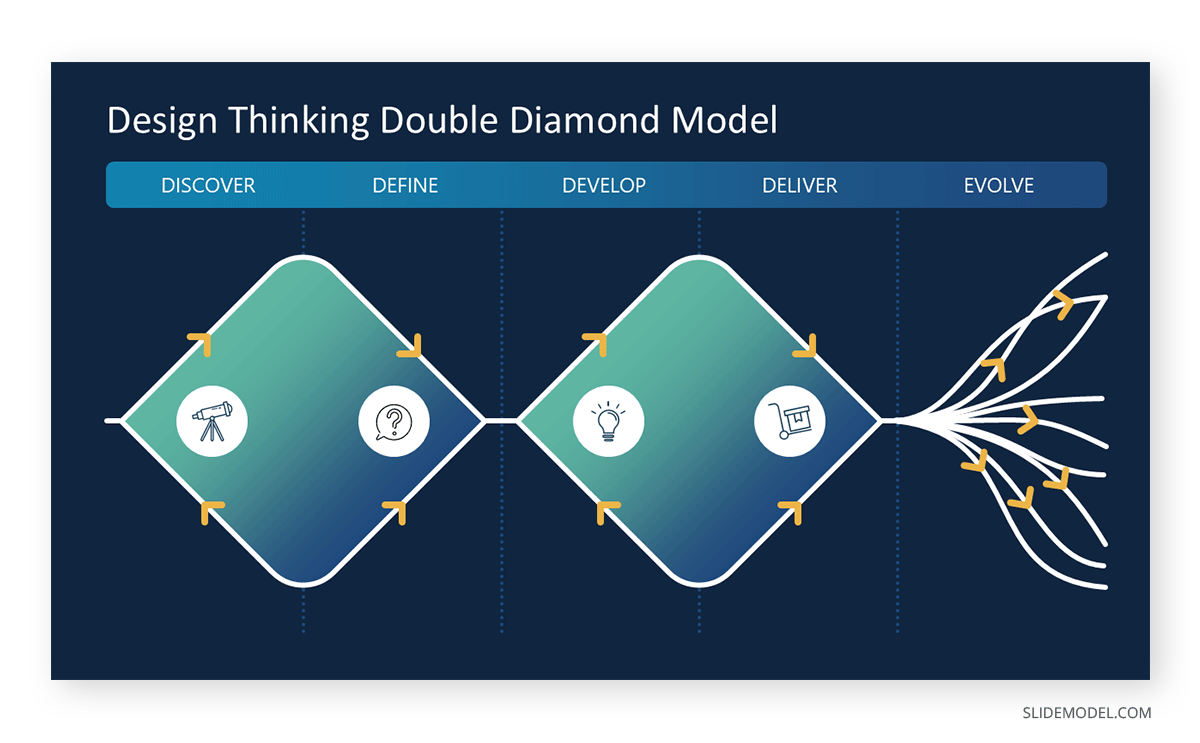
Problem-Solution Frameworks
This approach, often used in business pitches, presents a challenge, explains why it matters, and then introduces the recommended fix. The Double Diamond strengthens this by showing the journey between those two points. Instead of simply stating “Here’s the problem and here’s the solution,” you can show how you explored the problem in the Discover stage, narrowed it down in Define, tested multiple solutions in Develop, and refined the final choice in Deliver. This extra context reassures the audience that the recommendation wasn’t based on assumptions but on a structured decision-making process.
How to Use the Double Diamond in Presentation Design
To use the Double Diamond effectively as a presenter, you must treat it as both a planning tool and a storytelling presentation framework. This involves mapping your research, insights, and solutions into the four stages and then determining how to effectively translate them into slides and a spoken narrative.
Stage 1: Discover – Gathering and Framing Inputs
The Discover phase is about collecting raw material for your presentation. This implies identifying which inputs will matter to your audience. But then you may ask: “Okay, how do I frame it?”. Consider the following options:
- Conduct interviews, surveys, or workshops if the presentation involves stakeholder feedback.
- Gather quantitative data, such as market analysis or operational metrics, to give factual grounding.
- Review case studies or comparable scenarios to provide benchmarks.
Don’t discard insights too quickly; instead, categorize them so you can review the entire process and see if anything relevant could be added later on.
Stage 2: Define – Narrowing to the Core Problem
In the Define stage, you move from exploration to focus. For presentations, this is the pivot point where you transition from background to the specific challenge or opportunity your talk addresses. It means synthesizing findings into key themes, such as evident patterns and gaps.
By correctly addressing those elements, you can draft a clear problem statement that will anchor the rest of the presentation. This, in turn, validates your problem definition based on stakeholders’ views before even considering the discussion. Aim to summarize the problem into a concise, unambiguous sentence.
Stage 3: Develop – Exploring Solutions
The Develop stage is the creative counterpart to the Discover stage. Here, you explore multiple solutions before choosing one. In presentations, this is an opportunity to demonstrate that you didn’t default to the first idea.
Keep in mind that audiences do not need to see every discarded idea, as it would take an eternity to cover one topic otherwise. Instead, present 2-3 strong solutions that were considered, with their supporting evidence. Display, in a visual format, the evaluation criteria you applied to compare between options and, if relevant, showcase prototypes, mockups, or models derived from those findings (as long as they don’t contradict your core solution). A comparison chart template is ideal for this kind of stage.
Stage 4: Deliver – Presenting the Final Solution
The Deliver stage is where you present the chosen solution in detail. This is often the most anticipated part of the presentation, but its impact depends on how well you have built the case in earlier stages.
Present the final solution clearly, including specifications, scope, and/or core features. Speakers should outline the implementation plan, its timeline, and responsibilities. It’s a good practice to dedicate some moments to highlighting the main benefits of the solution as a response to the original problem statement, or to presenting metrics that showcase unique opportunities derived from it.
Don’t neglect discussing risk and mitigation strategies openly. In some scenarios, this is mandatory, and stakeholders will evaluate your professional performance and trustworthiness based on this.
FAQs
How is the Double Diamond relevant to presentations?
It gives presenters a logical way to structure content. Instead of jumping straight to the solution, it guides the audience through the journey: understanding the problem, seeing alternative solutions, and then learning why a specific solution was chosen.
Is the Double Diamond only for design projects?
No. While it originated in design, the process is applicable to any project that involves exploration, decision-making, and delivery. This includes strategy sessions, policy proposals, operational improvements, and innovation pitches.
How does the Double Diamond compare to the Pyramid Principle?
The Pyramid Principle structures arguments from the top down, starting with the main point. The Double Diamond focuses on the process leading to that point. You can combine them: use the Double Diamond to plan the narrative flow and the Pyramid Principle to structure each section’s arguments.
Can I skip stages if my audience is already familiar with the background?
Yes, but only if you are sure the audience is aligned on the problem. In that case, shorten the Discover and Define stages and dedicate more time to solution development and delivery.
What type of data works best in the Discover stage?
Quantitative metrics, market trends, user research findings, and stakeholder feedback. Combining complex data with qualitative insights strengthens credibility.
Does the Double Diamond work for persuasive sales presentations?
Yes. You can use it to demonstrate that your recommended product or service is the result of a rigorous problem–solution evaluation, rather than a prepackaged sales pitch.
What if my project didn’t follow the Double Diamond in reality?
You can still use the model to structure the story, but be transparent about deviations. Audiences value honesty, especially if you explain why a non-linear process worked in your context.
Final Words
The Double Diamond Model is a disciplined approach to structuring a story, from exploration to resolution, to maximize credibility while delivering a clear message. It helps balance creativity with focus, ensuring that audiences understand both the journey and the destination, and reinforces trust in your recommendations. When paired with strong slide design and a confident delivery, it can transform complex information into a coherent and persuasive narrative.
